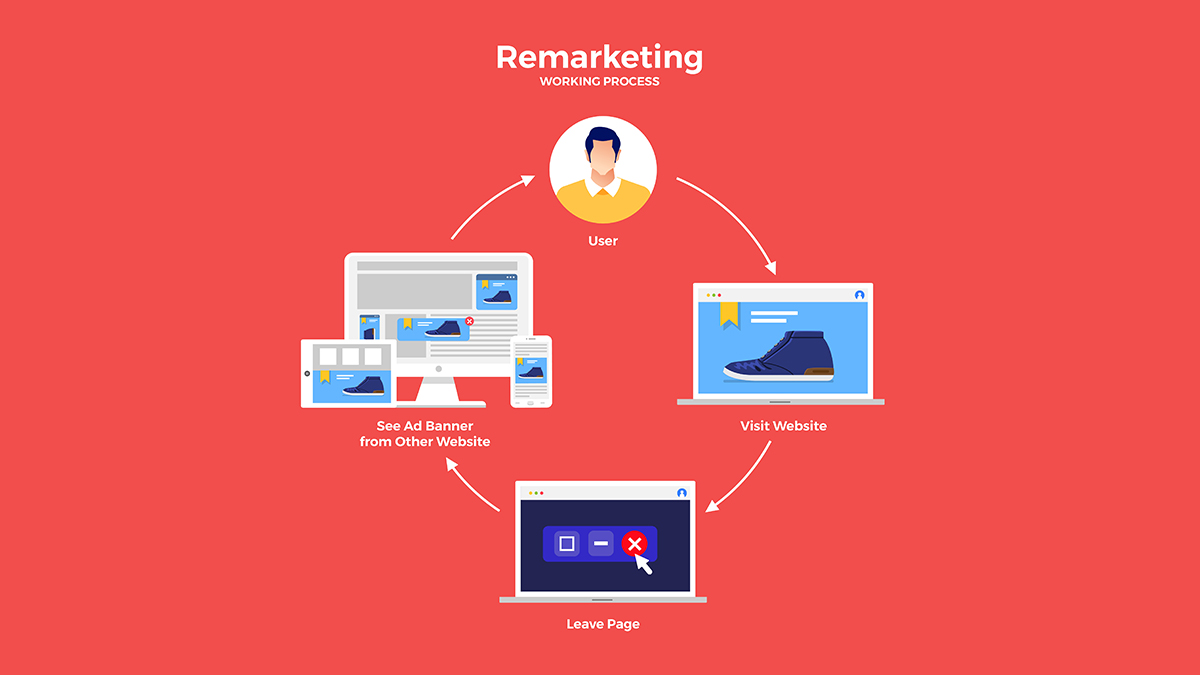Remarketing has become ubiquitous across the web, as users frequently gripe about endless ads chasing them around the web after viewing a product once.
Yet, when used correctly, in the box for paid media marketers across the spectrum of industries.
If you’ve tried remarketing and haven’t seen a return, I’d like to share a few ideas for new segmentation and different types of audiences you may not have tested.
In keeping up with increasing restrictions on tracking capabilities, ad platforms continue to roll out new options for reaching users outside of the box of traditional pixel-based remarketing.
First, let’s start with a basic definition for those who may be less familiar with the tactic.

What Is Remarketing?
Remarketing (sometimes called retargeting) is a paid marketing tactic allowing you to serve ads to individuals who have previously visited a website or engaged with your content on a social channel.
Website-based remarketing utilizes a pixel placed on the website to reach individuals who have visited specific pages or performed certain events.
Meanwhile, engagement-based remarketing allows you to reach those who have interacted with your social media content or watched a video.
Read on to discover eight types of remarketing you should be considering for your campaigns.
1. Pricing Page Visitors
If a shopper visits a pricing page, they’re likely further along in the product research process than somebody else who sees the homepage.
They may be comparing costs versus competitors and digging into the specific features available by pricing tier.
Bucketing out pricing page visitors into their category can produce a higher intent audience than you’d get targeting all visitors as a whole.
These individuals may be more willing to respond to a call-to-action for a product demo or a call with a salesperson.
You could also put together an asset with tips for evaluating products in your industry, which may appeal to people making product comparisons.
For example, my past client, who sold board management software, offered a worksheet for evaluating board software, serving remarketing ads on display and social to convince previous visitors to supply their email addresses.
2. Industry-Specific Page Visitors
Segmenting audiences by industry can be complicated when attempting to market to people in niche industries.
If you have pages on your site dedicated to each industry, you can build separate remarketing audiences for each of those pages.
Effectively, you’ll now create buckets of people who have raised their hands saying they’re interested in services for a particular industry.
You can target unique ads tailored by industry to speak more specifically to these people based on their needs.
For instance, you might have a guide explaining how real estate developers can use your software to track prospects and target that to people who visit a real estate industry page.
You may also have different product lines or pricing for various industries.
For instance, many companies offer discounted services for nonprofits and want to target those groups separately.
3. Cross-Channel Remarketing
Take full advantage of cross-channel opportunities by building remarketing segments for people who visited your site from specific channels and campaigns.
It is a great way to carry audience targeting options from one platform to another.
In addition, you can take advantage of lower costs in some platforms versus others for remarketing.
For instance, if you’re running, you may want to target people who clicked an ad from a campaign targeted to C-suite individuals.
Via a URL-based audience, you can effectively target the people who fit the LinkedIn profile targeting criteria using any other channel, paying the lower costs of a network such as Google Display.
As long as you tag your links with a consistent, you can copy the landing page, and associated tags into the “URL Contains” field when setting up a remarketing audience.
This solution allows you to pay for LinkedIn visitors upfront using their built-in targeting but avoid the high costs of LinkedIn for remarketing within their platform.
4. Cart Abandoners
went through the work of finding a product they wanted and adding it to their cart without finalizing the checkout process.
Remarketing to people with these ads can encourage them to return to the site and complete their purchases.
Including an offer may also entice people to come back and finish buying. However, it would be best if you were careful that people don’t simply come to expect they can manipulate the process to receive a discount.
It can also be a time to reiterate selling points for your brand.
For instance, if you offer a two-year warranty when most competitors only offer one year, call that out in ads.
Make the case to bring people back in, which may be the nudge to shift them over the edge into a buying mood.
5. Previous Purchasers
If someone bought from your site in the past, you could remarket them later to encourage them to make another purchase.
The products you promote and the timing for future remarketing depends on the type of product purchased.
For instance, if somebody just bought a new backpack, they may be open to purchasing related gear like a hiking pole.
If someone orders a printer, they likely don’t want another printer immediately but may need replacement ink cartridges six months later.
You should exercise caution not to annoy people because they form a negative perception of your brand after already completing a purchase, so don’t try this too soon.
Also include frequency caps where channels allow.
6. Higher Funnel Converters
Particularly for the B2B world, converting a prospect to a sale often entails a lengthy process of multiple touchpoints.
Offering a downloadable asset like a guide, or inviting people to sign up for a webinar, can build an audience of people who are interested enough to raise their hands.
You can then build remarketing lists based on people who download a higher funnel asset, setting up a new campaign targeting those with lower funnel call-to-action, such as a product demo.
You could target this via a website pixel (reaching people who have previously filled out a specific form) or via lead form retargeting in Meta or LinkedIn (reaching people who have filled out an in-platform form).
Think through the buying stages for your target personas and build out remarketing for people who interact at each part of the process.
7. Video Viewers
Remarketing can capture intent from people who haven’t even visited your website.
YouTube, Meta, and LinkedIn are three popular channels allowing for the creation of view remarketing audiences.
Within YouTube, you can segment people based on the following criteria:
- Viewed any video from a channel.
- Viewed certain videos.
- Viewed any video (as an ad) from a channel.
- Viewed certain videos (as ads).
- Channel interactions, including visits, subscriptions, and video likes.
Within Meta, you can segment people based on the following criteria for any video or set of videos you select:
- Viewed a video for at least three, 10, or 15 seconds.
- Watched a video to 25%, 50%, 75%, or 95%.
Finally, LinkedIn allows you to segment video view audiences by 25%, 50%, 75%, or 95%.
Creating audiences of people who have committed to watching all or most of your video can segment out higher-intent people who may be more likely to download an asset or want to attend a webinar.
People who watched shorter lengths of time may still be willing to view additional content in future remarketing campaigns.
8. Page Engagers
Facebook/Instagram page engagement audiences, available within the Meta Ads interface, allow for another way to capture user intent outside your site.
If a user chooses to like or comment on a Facebook post, they’re indicating some level of interest in what you have to offer.
Currently, you can target people based on the following criteria:
- People who like or follow your page.
- Everyone who engaged with your page.
- Anyone who visited your page.
- People who engaged with any post or ad.
- People who clicked any call-to-action button.
- People who sent a message to your page.
- People who saved your page or a post.
You can also combine these criteria to include/exclude people from a group to target.
For instance, you could reach people who have visited your page but do not currently like or follow it.
Additionally, LinkedIn allows you to retarget people who have engaged with your single image ads.
You can choose from any engagement (people who reacted or commented, as well as clicked) or limit it to only chargeable clicks.
Revamp Your Remarketing Campaigns
You’re ready to test some new remarketing methodology in your campaigns.
Think through new audiences that make sense for your brand and, and start by building them out.
If you’re unsure that the audiences will be large enough to justify segmenting, build them and see how big they become over time.
Be sure to incorporate engagement-based and website visit-based audiences to future-proofing against tracking limitations.
Remember that social platform engagers are first-party audiences and more reliable than third-party audiences built via a pixel, so they will likely contain a larger pool of the individuals you’d like to target.
Finally, don’t forget to develop unique and creative messaging to speak to each audience. Launch your campaigns, and start!







